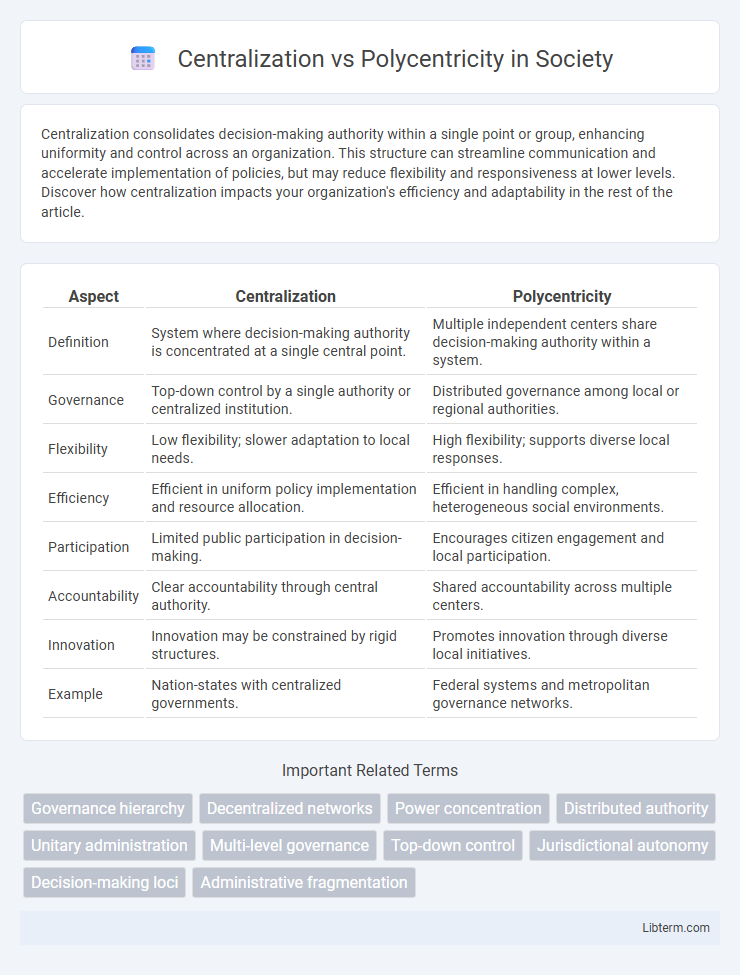Centralization consolidates decision-making authority within a single point or group, enhancing uniformity and control across an organization. This structure can streamline communication and accelerate implementation of policies, but may reduce flexibility and responsiveness at lower levels. Discover how centralization impacts your organization's efficiency and adaptability in the rest of the article.
Table of Comparison
| Aspect | Centralization | Polycentricity |
|---|---|---|
| Definition | System where decision-making authority is concentrated at a single central point. | Multiple independent centers share decision-making authority within a system. |
| Governance | Top-down control by a single authority or centralized institution. | Distributed governance among local or regional authorities. |
| Flexibility | Low flexibility; slower adaptation to local needs. | High flexibility; supports diverse local responses. |
| Efficiency | Efficient in uniform policy implementation and resource allocation. | Efficient in handling complex, heterogeneous social environments. |
| Participation | Limited public participation in decision-making. | Encourages citizen engagement and local participation. |
| Accountability | Clear accountability through central authority. | Shared accountability across multiple centers. |
| Innovation | Innovation may be constrained by rigid structures. | Promotes innovation through diverse local initiatives. |
| Example | Nation-states with centralized governments. | Federal systems and metropolitan governance networks. |
Defining Centralization and Polycentricity
Centralization refers to the concentration of decision-making authority at the top levels of an organizational hierarchy, enabling uniform policies and streamlined control. Polycentricity describes a decentralized structure where multiple centers of decision-making operate independently within a system, promoting local responsiveness and adaptability. These concepts impact governance, with centralization favoring cohesion and efficiency, whereas polycentricity emphasizes flexibility and diverse stakeholder engagement.
Historical Context of Decision-Making Structures
Centralization in decision-making structures historically emerged during the Industrial Revolution, enabling rapid coordination and control in expanding enterprises and governments. Polycentricity gained prominence in the late 20th century with globalization, reflecting decentralized authority that accommodates diverse local contexts and fosters innovation across multiple centers. The shift from centralized to polycentric frameworks illustrates evolving organizational responses to complexity, technological advances, and the need for agile governance.
Key Features of Centralized Systems
Centralized systems concentrate decision-making authority at the top levels of management, ensuring consistent policies and unified control across the organization. Key features include standardized procedures, streamlined communication, and efficient resource allocation, which reduce redundancy and enhance coordination. This structure supports quick decision-making and maintains uniformity in operations, critical for organizations requiring tight control and consistency.
Characteristics of Polycentric Approaches
Polycentric approaches are characterized by decentralized decision-making, allowing multiple centers of authority to operate independently within a larger system. They emphasize local autonomy, adaptability, and context-specific solutions that reflect the diverse needs of different regions or communities. This structure enhances responsiveness, fosters innovation through varied perspectives, and reduces the risks associated with centralized control.
Advantages of Centralization
Centralization enhances decision-making efficiency by consolidating authority within a single headquarters, ensuring consistent policy implementation across all branches. It streamlines communication channels, reducing the risk of misunderstandings and accelerating response times in dynamic business environments. Organizations benefit from cost savings through standardized procedures and centralized resource allocation, improving overall operational control.
Benefits of Polycentricity
Polycentricity enhances local decision-making by empowering regional authorities, leading to policies that better reflect diverse community needs. This decentralized approach fosters innovation through competitive governance and improves resource allocation by tailoring solutions to specific socio-economic contexts. As a result, polycentric systems can increase resilience and adaptability compared to centralized models.
Challenges of Centralized Governance
Centralized governance faces challenges such as slowed decision-making due to hierarchical layers, which can impede responsiveness and innovation in dynamic environments. It often results in reduced local autonomy, leading to mismatched policies that fail to address region-specific needs effectively. Furthermore, centralized systems risk overburdening top-level administrators, creating bottlenecks that hinder efficient resource allocation and service delivery.
Drawbacks of Polycentric Models
Polycentric models often suffer from inconsistent decision-making and coordination challenges due to autonomous local units operating independently. This fragmentation can lead to inefficiencies in resource allocation and difficulties in maintaining a unified corporate strategy. Moreover, increased administrative costs and complexity arise from managing multiple centers of authority across diverse geographic locations.
Case Studies: Real-World Applications
Centralization in multinational corporations often leads to streamlined decision-making and uniform policies, as exemplified by Samsung's Seoul headquarters overseeing global operations. Polycentricity allows subsidiaries significant autonomy to adapt strategies locally, seen in Unilever's approach where regional managers tailor marketing campaigns to specific cultural preferences. Case studies indicate that firms adopting polycentric structures typically experience higher local market responsiveness, while centralized models benefit from cost efficiencies and consistent brand identity.
Choosing the Right Approach for Organizations
Centralization consolidates decision-making authority at higher management levels, enhancing control and uniformity across organizations, ideal for consistent strategy execution. Polycentricity delegates authority to local units, fostering responsiveness and cultural alignment, crucial for multinational corporations navigating diverse markets. Evaluating organizational goals, market complexity, and resource availability helps determine the optimal balance between centralized control and decentralized autonomy.
Centralization Infographic

 libterm.com
libterm.com